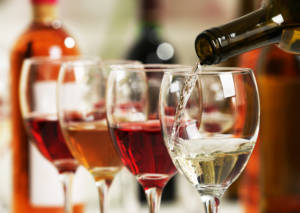A Quick Crash Course on Wines for Your Wedding Reception

Serving wines is a must at most wedding receptions, but the endless varieties can be overwhelming. Read this quick primer to help you navigate your options.
Wine is a staple at many wedding receptions, but it’s easy to find the endless varieties confusing. This is especially true if you aren’t familiar with wine varieties and their unique properties. If you can barely tell the difference between white and red wines, you’re going to need some assistance navigating your wine selection. Fortunately, a quick guide can help you begin to understand your options.
Wines 101: White, Red, and Sparkling
There’s more to red and white wines than just their hues, as Wine Folly explains. Red varieties are usually fermented with grapes’ skins and seeds, while white wines are not. Different oxidation methods are used, with red wines aging in oak barrels and white vintages aging inside stainless steel tanks. Oak barrels increase exposure to oxygen, resulting in darker wines’ rich, bold flavors. Conversely, stainless steel tanks reduce oxygen exposure to give white wines their bright, zesty and fruity taste.
Sparkling wines are so named for their carbonation, resulting from a second fermentation process. Vine Pair describes how this works. After the primary fermentation occurs, yeast in the wine is encouraged to activate and consume leftover sugars. The result is excess carbon dioxide, which produces the familiar bubbles. Champagne is eponymous thanks to the region in which it’s made, but it’s only one type of sparkler. Prosecco, Cava, and Lambrusco are other popular kinds, and sparkling vintages can come in white, red, or blush-pink rosé.
Choosing Your Wine Selections
How do you determine which wines to serve at your reception? A lot of factors can influence your decision, but you may benefit from some useful advise. Wedding Wire Canada’s Alice Prendergast cautions against offering too many choices, so keep your selection simple. One white and one red is the standard advice, but The Knot recommends adding one sparkling variety to your menu. Also, don’t worry about serving strictly seasonal vintages. Your guests will appreciate what you serve as long as it’s thoughtfully selected and complements your meal.
Decoding Food and Wine Pairings
Some tastemakers elevate food and wine pairing to an art form. For the rest of us, a few rules can guide our choices. Food & Wine provides some simple suggestions to help you get started:
- A dry rosé works well with most hors d’oeuvres.
- Unoaked white wines are ideal for most seafood, especially fish and shellfish that are complemented by citrus flavors.
- Sweet or low-alcohol wines pair best with spicy foods.
- Rich red meat benefits from bold red vintages.
- For lighter meats, pair the wine to its type of sauce.
- Earthy wines are perfect companions to earthy foods.
- Lighter ones are excellent for dessert.
For couples serving vegetarian menus, Vegetarian Times offers more great tips. For instance, sweet vintages contrast well with the piquant heat in Indian, Thai, or other spicy cuisines.
After you’ve picked your drink menu, don’t forget a few serving hints to get the most out of your wines. Vine Pair suggests temperature ranges of 40 to 50 degrees Fahrenheit for sparkling wines, 50 to 60 degrees for white and rosé varieties, and 60 to 70 degrees for reds. For best results, keep pours consistently to 3 ounces per glass. To ensure that you have enough for your crowd, budget for one bottle per guest and add a few extras just in case.
Maximum Enjoyment for Your Guests
Wine is a vital part of the hospitality you extend to friends and family at your wedding. When catering to your crowd, a limited yet varied menu is best. For food and wine pairings, choose vintages that match your dishes’ flavor intensities. Wines should be served cold to best enhance their natural flavors and aromas.

